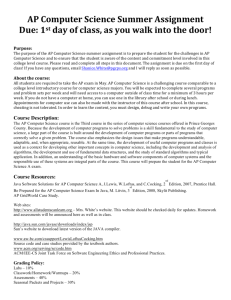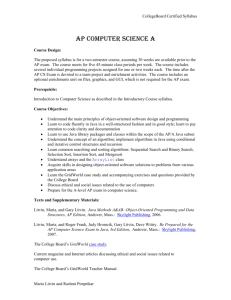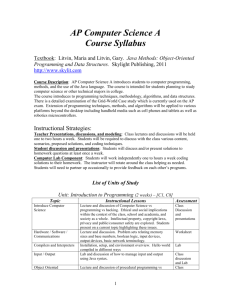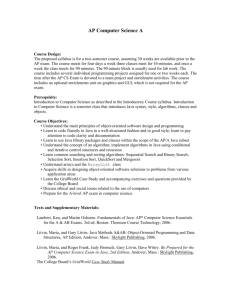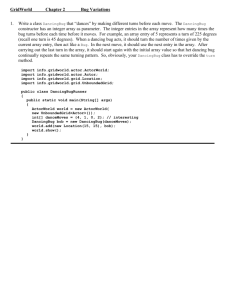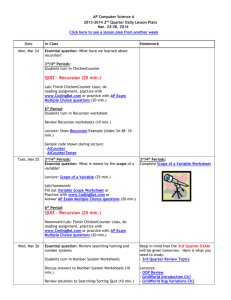AP Computer Science A
advertisement
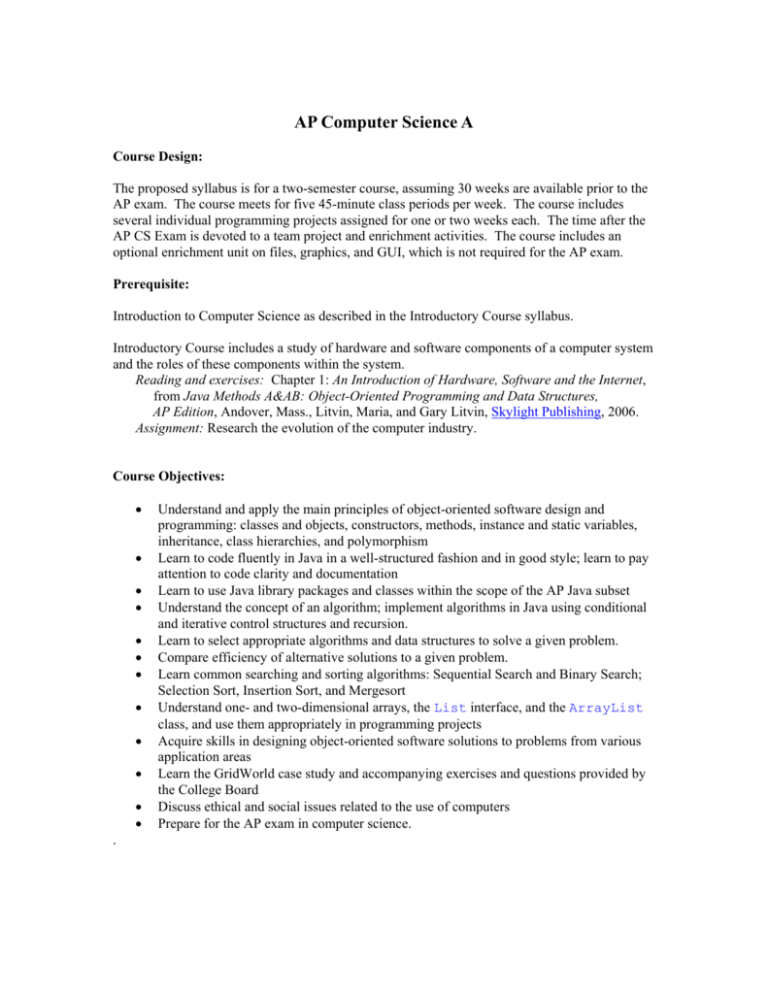
AP Computer Science A Course Design: The proposed syllabus is for a two-semester course, assuming 30 weeks are available prior to the AP exam. The course meets for five 45-minute class periods per week. The course includes several individual programming projects assigned for one or two weeks each. The time after the AP CS Exam is devoted to a team project and enrichment activities. The course includes an optional enrichment unit on files, graphics, and GUI, which is not required for the AP exam. Prerequisite: Introduction to Computer Science as described in the Introductory Course syllabus. Introductory Course includes a study of hardware and software components of a computer system and the roles of these components within the system. Reading and exercises: Chapter 1: An Introduction of Hardware, Software and the Internet, from Java Methods A&AB: Object-Oriented Programming and Data Structures, AP Edition, Andover, Mass., Litvin, Maria, and Gary Litvin, Skylight Publishing, 2006. Assignment: Research the evolution of the computer industry. Course Objectives: • • • • • • • • • • • • . Understand and apply the main principles of object-oriented software design and programming: classes and objects, constructors, methods, instance and static variables, inheritance, class hierarchies, and polymorphism Learn to code fluently in Java in a well-structured fashion and in good style; learn to pay attention to code clarity and documentation Learn to use Java library packages and classes within the scope of the AP Java subset Understand the concept of an algorithm; implement algorithms in Java using conditional and iterative control structures and recursion. Learn to select appropriate algorithms and data structures to solve a given problem. Compare efficiency of alternative solutions to a given problem. Learn common searching and sorting algorithms: Sequential Search and Binary Search; Selection Sort, Insertion Sort, and Mergesort Understand one- and two-dimensional arrays, the List interface, and the ArrayList class, and use them appropriately in programming projects Acquire skills in designing object-oriented software solutions to problems from various application areas Learn the GridWorld case study and accompanying exercises and questions provided by the College Board Discuss ethical and social issues related to the use of computers Prepare for the AP exam in computer science. Syllabus: AP Computer Science A 2 Texts and Supplementary Materials: Litvin, Maria, and Gary Litvin. Java Methods A&AB: Object-Oriented Programming and Data Structures, AP Edition, Andover, Mass.: Skylight Publishing, 2006. Litvin, Maria, and Gary Litvin. Be Prepared for the AP Computer Science Exam in Java, 4th Edition, Andover, Mass.: Skylight Publishing, 2009. The College Board’s GridWorld case study, Parts 1-4. Litvin, Maria, and Gary Litvin. 250 Multiple-Choice Computer Science Questions in Java. Andover, Mass.: Skylight Publishing, 2008. Current magazine and Internet articles discussing ethical and social issues related to computer use. Teacher Materials: The College Board’s Computer Science A Course Description. The College Board’s GridWorld Teacher Manual. AP Central resources. Java Methods Student Disk, Teacher Disk, PowerPoint slides, Test Package, additional resources at http://www.skylit.com/javamethods and http://www.skylit.com/oop. Course Outline: Chapter numbers for readings and exercises refer to Java Methods A&AB, AP Edition. The labs, case studies, and projects proposed below come from Java Methods and serve only as examples of possible assignments; the teacher’s favorites may be used instead. GridWorld refers to the College Board’s GridWorld case study narrative. Unit 1: Review of the introductory material (4 weeks) 1. Java syntax and style (Weeks 1-2; duration 2 weeks) Import statements and library classes. Comments. Indentation and braces. Primitive data types. Declaring fields and local variables. Arithmetic operators. Boolean expressions, relational and logical operators. Reading and exercises: Chapters 5-7, Appendix A. Labs: Exercises and/or free-response questions from the Test Package for Chapters 5-7. 2. Review of algorithms (Week 3; duration 1 week) Algorithms using iterations and recursion. When not to use recursion (e.g., Fibonacci Numbers). Reading and exercises: Chapters 4 and 8. Labs: Exercises and/or free-response questions from the Test Package for Chapters 4 and 8. Syllabus: AP Computer Science A 3. Review of classes and objects (Week 4; duration 1 week) Classes and objects. Variables, constructors and methods. An introduction to inheritance. First Steps case study review. Reading and exercises: Chapter 3. Lab: “Bystander” in First Steps (Exercise 3-12). Unit 2: Classes, class hierarchies, GridWorld (7 weeks) 4. An introduction to GridWorld (Week 5; duration 1 week) Experimenting with the GridWorld GUI. An overview of the classes and objects involved. Role-play exercise. Reading and exercises: GridWorld Part 1. Lab: Set up a GridWorld project and run BugRunner. Lab: Simple extensions of the Bug class. 5. Details of defining classes and using objects (Weeks 6-7; duration 2 weeks) Public and private fields and methods. Constructors and the new operator. References to objects. Calling methods and accessing fields. Passing parameters to constructors and methods. return statement. Overloaded methods. Static variables and methods. GridWorld continued. Reading and exercises: Chapter 9; GridWorld Part 2. Lab: Snack Bar. Lab: GridWorld exercises for Part 2 (page 12). 6. Strings (Week 8; duration 1 week) String objects. Literal strings. Immutability. String methods. Converting strings into numbers and numbers into strings. The Character class and its methods. Reading and exercises: Chapter 10. Lab: Lipograms (Section 10.8). 7. Class hierarchies, abstract classes, and interfaces (Weeks 9-11; duration 3 weeks) Class hierarchies. Polymorphism. Abstract classes. Invoking superclass’s constructors and calling superclass’s methods. Case Study: Dance Studio. Interfaces. Reading and exercises: Chapter 11, GridWorld Part 3. Lab: Dance Studio. Lab: Past free-response questions on class hierarchies and polymorphism. Lab: Creating a subclass of Actor, GridWorld Part 3 group activity (p. 24). 3 Syllabus: AP Computer Science A 4 Unit 3: Arrays, the List interface, ArrayLists, searching and sorting (8 weeks) 8. Arrays (Week 12; duration 1 week) One-dimensional arrays. Arrays as objects. Declaring and initializing. Indices. Length. IndexOutOfBoundsException. Reading and exercises: Sections 12.1-12.3. Lab: Fortune Teller (Section 12.3). 9. ArrayLists; algorithms for arrays and ArrayLists (Weeks 13-14; duration 2 weeks) The List interface. ArrayList’s constructors and methods. Traversals and the “for each” loop. Finding the largest and the smallest element. Inserting and removing elements. When to use arrays and when — ArrayLists. ArrayLists in GridWorld. Reading and exercises: Sections 12.4-12.9, GridWorld Part 4. Lab: Creating an Index for a Document (Section 12.9). Lab: Past free-response questions on arrays and ArrayList. Lab: GridWorld Part 4 exercises (p. 32). 10. Two-dimensional arrays (Weeks 15-16; duration 2 weeks) Declaring 2-D arrays. Indices. Accessing the number of rows and columns. Traversals. Reading and exercises: Sections 12.10-12.11. Lab: Chomp (Section 12.11). 11. Searching and sorting. Introduction to analysis of algorithms. (Weeks 17-19; duration 3 weeks) Comparing objects. The equals method and the Comparable interface. Sequential and Binary Search. Selection Sort, Insertion Sort, and Mergesort. The java.util.Random class. The number of comparisons required in Sequential and Binary Search. Comparison of efficiency of “quadratic” sorting algorithms (Selection Sort and Insertion Sort) vs. Mergesort. Reading and exercises: Chapter 13. Lab: Chapter 13 exercises (e.g., 13-4, 13-9). Lab: Keeping Things in order (Section 13.4). Lab: Benchmarks (Section 13.9) — compares efficiency of several sorting algorithms. Unit 4: Enrichment (optional, 5 weeks) 12. Streams and files (Weeks 20-21; duration 2 weeks) Text and binary files. Streams vs. random-access files. Java I/O package. The Scanner class. Checked exceptions. Reading and exercises: Chapter 14. Lab: Dictionary for Ramblecs (Section 14.5). Lab: Exercises and projects from the Test Package for Chapter 14. Syllabus: AP Computer Science A 13. Graphics and GUI (Weeks 22-24; duration 3 weeks) Computer graphics concepts. The Java Graphics class. GUI components and their events. Layouts. Handling mouse and keyboard events. Reading and exercises: Chapters 15, 16, 17. Lab: Pieces of the Puzzle (Section 15.7). Programming project: Ramblecs (Section 16.6). Programming project: Drawing Editor (Section 17.4). Unit 5: Review (6 weeks) 14. GridWorld review (Weeks 25-27; duration 3 weeks) Review of the GridWorld classes and interfaces. Modifications and exercises. Reading and exercises: GridWorld Parts 1-4; Be Prepared Chapter 6. Labs: GridWorld Enhancements (from suggested exercises for Part 4, p. 32, and Be Prepared). 15. Review and practice for the exam (Weeks 28-30; duration 3 weeks) Reading: Be Prepared Chapters 1-5; Be Prepared Chapter 7 (past free-response questions and solutions), Be Prepared practice exams, 250 Multiple-Choice Computer Science Questions. Unit 6: After the AP exam (Duration varies) Suggested activities: a team project to implement a game (for example, the Game of SET, http://www.skylit.com/oop or Battleship or a project based on GridWorld); a potentially useful project for the school; student presentations on ethical and social issues related to the use of computers (Appendix F). 5
